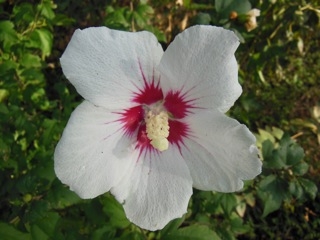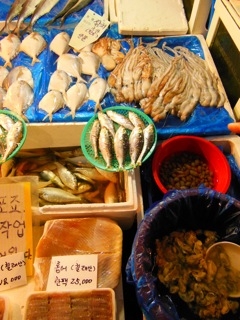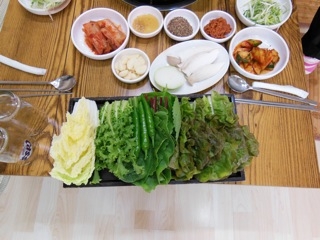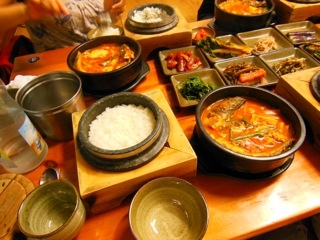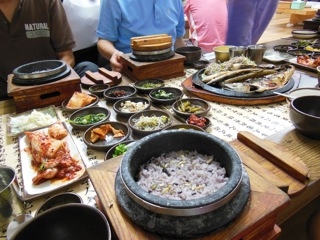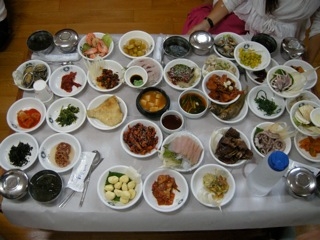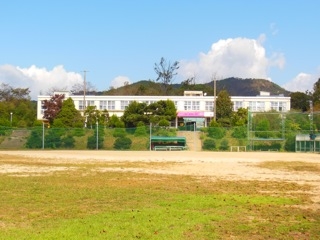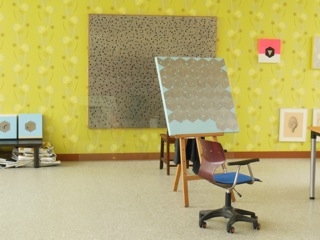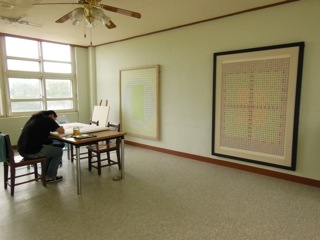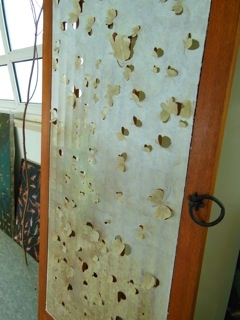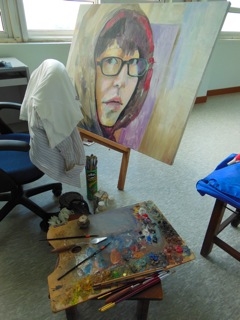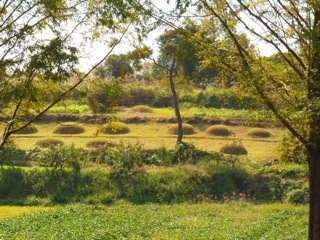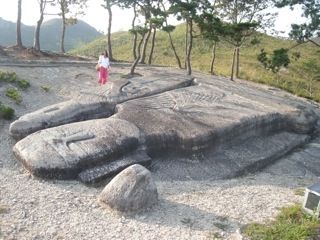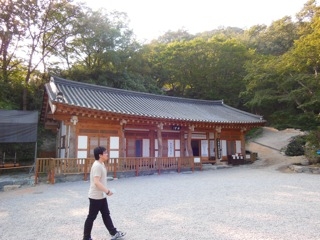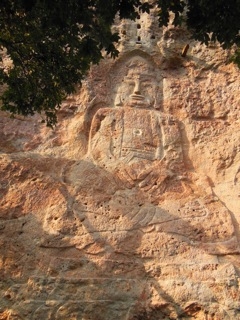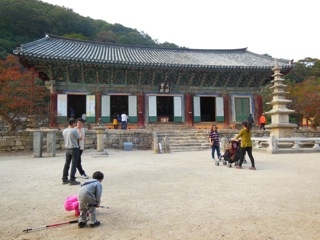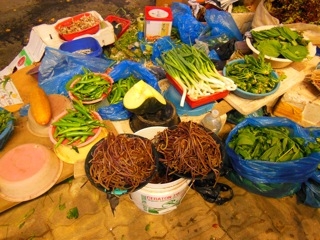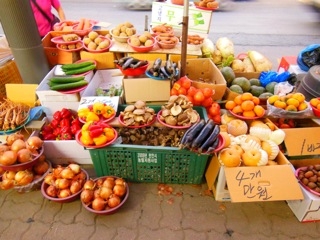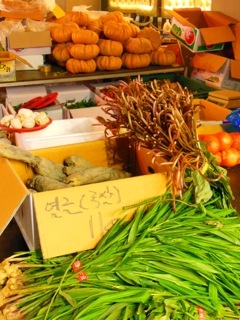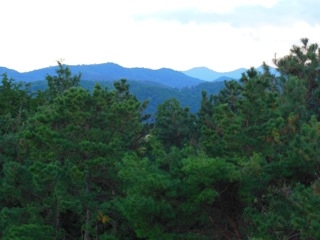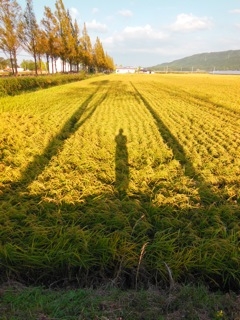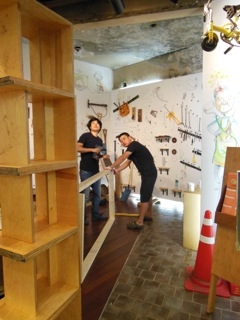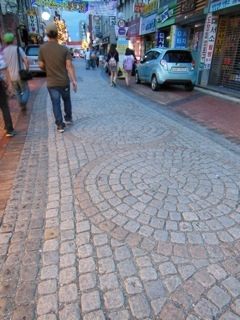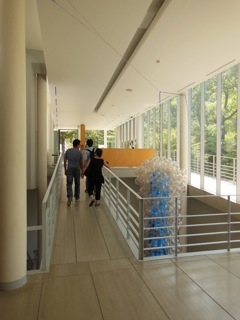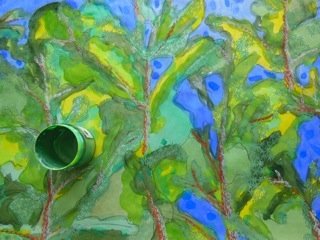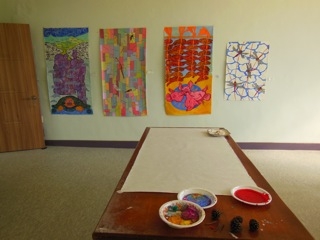Full Circle- Penang- Gwangju- Penang
First published on 05 Nov 2012 (2129 days ago)
It's been nearly a month since I got back to Penang & I am still thinking everyday, of my time in Korea. 40 days has had quite an impact on me! And I believe, it has all been extremely positive mentally & physically, body & soul. I couldn't have done better if I'd spent 40 days at some snazzy spa..& I really mean that. I also learnt a huge amount from the whole experience.
Everything there agreed with me, especially the bit where I didn't have to go around doing anything else except paint & breathe in the atmosphere of the place! I worked solidly for hours on end in the studio during the week & at weekends we had new friends & colleagues kindly show us around what they thought was special in Gwangju. It was marvelous to be painting everyday.
Food, drink & bad breath
The food in Korea completely agreed with me. I felt good, I felt energetic, not once did I feel uncomfortable after a meal & I was never hungry. Part of this is I'm sure, the fact that I kept to a fairly rigid routine. Tea or coffee for breakfast with an apple at 7'ish am. Tea or coffee break at about 10am. Lunch about 12.30( we cooked at the studio during all weekdays & a couple of weekends). Tea break about 4.30 & then supper at about 7.30 to 8pm.
Rice was had at pretty much every meal, as was Kim Chee. I was told that Kim Chee was good for the digestion as it contained 'good' bacteria, a bit like yogurt, & I now totally believe this. I never actually had bad breath from it, despite the name of one of my paintings, & I noticed that not 1 person I met or spoke to had bad breath. Strange thing to notice you may say, but here in George Town I often have major garlic breath after a meal & certainly I notice it on the breath of many people here! Garlic in Korea seems to be eaten raw, thinly sliced & in moderation, as a condiment, not as an ingredient as such.
Meat was eaten in moderation, fish more often but there was always fresh salad & herb leaves with the meal. Lots of preserved vegetables too & steamed root vegetables & beans. Instead of one large dish of one type of food per person, the norm is to bring a wide selection of small dishes to the table & everybody helps themselves delicately using stainless steel chopsticks. Stainless steel chopsticks, a stainless steel spoon with a long handle & a bowl for rice is your full table setting. The stainless steel chopsticks make sure you don't gobble your food down. They don't seem to shove food into their mouths from the side of the bowl. You may get an extra little side dish for putting bits on.
The style of cooking was also significant. Meat is cooked on a hot plate after being marinated, or it is cooked as a stew with gravy. Soups are extremely popular. Fish can be fresh or preserved, or raw. Free range(only) chicken gizzards can be eaten raw too! Typically all the small dishes get served first at once with rice. Then the central dish- normally a hot pot of some kind- is presented on to the table. Rice is served to you in a hot stone bowl- it looks a bit like the granite pounding bowl we get here. You scoop your rice into your bowl & then fill the stone bowl with hot water which softens all the rice stuck to the bottom. At the end of the meal, you eat the rice porridge formed in the stone bowl on its own. It has a surprisingly nutty & comforting taste & I believe totally that this rice porridge is partly responsible for keeping your tummy settled after each meal. It is very comforting.
Every meal in every restaurant is completed with free coffee- mild, creamed & just slightly sweet. You serve yourself from a small vending machine. I was also charmed by the routine in many of the restaurants, especially the larger ones, Buddhist or vegetarian, of having to take your empty plates to the counter, tip rubbish into a container & separate your cutlery from your dishes in readiness to hand over to the dishwasher. At the temple we went to & had lunch, you have to take your dishes & wash them up. It was also considered bad form to not finish all the food you placed on your plate. I loved this & it made total sense to me. Like Buddha in the Diamond Sutra- you eat & then wash your bowl.
There were 3 things I didn't like or wouldn't eat. I thought the preserved 'kenyip' leaves were horrible( but I loved the fresh ones). I refused to eat the cicada chrysalides & the still moving chopped up bits of raw octopus.
I have never drunk so much coffee. We only had water, coffee 3 in 1's( the brand, Maxim, of which I have been delighted to have found here at the Korean mini-mart at Island Plaza!) & green tea. I bought the only brand of black tea I could see at Homeplus( essentially Tesco) & everyone at the studio expressed great surprise when I put milk into it. They had never seen this before. We weren't inclined to buy any other beverage. There are coffee shops every 2nd or 3rd shoplot along every street. They are called 'coffices' with names such as 'Express Olic', 'Pastabucks', 'Cafe D'lunch' & theres about 250 of them in Gwangju. They also serve tapioca lattes which are yummy! They are all comfy, eclectically decorated, cosy places to be & everyone hangs out in there. Starbucks is around too.
The weather was perfect. Autumn. 23 to 24 degrees during the day, down to 18 or 19 at night. Fresh air, no pollution in the countryside. I slept like a baby most nights at the studio, solidly, waking up in the same position I had fallen asleep in. The mattress was on the hard side & we had traditional bedding of a quilt for the top of the mattress & a quilt for a cover. The night was full of the sound of crickets, no compressors, no traffic, no nightclubs- dark & silent. The sound of birds in the morning was my alarm, lots of wonderful insects & tree frogs, little mongoose's running around the countryside & the show that is autumn taking place right where we were. The roadside verges changed each day, the trees started to change colour, the rice fields changed from green to golden, & the mountains were a constant steadying backdrop. These are all utterly beautiful in Gwangju. I couldn't have asked for a better place to be for me. And both Chan & myself felt that we had really lucked out with the location of the studio.
Ancient history, outrageous work ethic & lots of surprises
There was so much about South Korea of which I was clueless. It has a population of around 50 million & is approximately a third the size of Malaysia. It has an ancient history which is mind boggling, going back to the Stone Age. And let me tell you, they worked as hard then as they do today. 40% of the worlds dolmen stones(goindol) are on the Korean Peninsular, an estimated 35,000 of them built in the First Millennium BC! Get your head around that! You can just imagine even then, the people of Korea were working long hours chipping at these giant granite stones. They had to be. There are so many of them scattered about the countryside! They are compared to Stonehenge, 'dolmen' meaning 'stone table'. Large granite stones were erected & placed on 'foot' stones, looking like a giant table, or above ground as a four sided chamber, or a pit covered with a slab. On our little trips at weekends I kept seeing signs for 'Stone Age Site' & I was thinking 'Huh?' each time I saw one. I need to go back to actually see them.
In Korea today all around the countryside you will see tumuli, little earth mounds perfectly shaped & covered in grass- small family gravesites. A family can purchase a bit of land anywhere & erect these mounds for their dead. They also place large granite tombstones either on them or near them, the modern dolmen stone. They are scattered all over the countryside & these tumuli definitely hark back to an ancient time & the practice of using earth mounds to mark a gravesite.
Then there is the ancient petroglyph of Bangudae. Rock art depicting an intense whale hunting scene, so detailed the type of whales can be identified, the type of nets the fishermen used, even the details of the hunters clothing, their faces, shape of boats, wild boar, tigers, an amazing work of art. There are 200 individual motifs chiseled out of the rock by people at the start of the Bronze age at around 2,500BC. I for one, in my ignorance, had always associated dolmen, tumuli & ancient Stone Age cave art with Europe.
We had been taken to a couple of Temples. Unjasa & Seonunsa. At both there are mesmerizing ancient stone carvings of Buddha. At Unjusa I was immediately reminded of the Easter Island statues & so turned to Google to do some research. The first of the Buddha statues at Unjusa were thought to have been made at approximately 57BC. (The Easter Island statues started from about 1000BC.) It was from here that I started a bit of research on Korean ancient history & I have been totally fascinated & awed by it.
Koreans are the most homogeneous race on the planet. There has not been much interracial mixing at all & this can really, to me, explain a lot of things. The fact that they generally behave the same way, are so proud of the fact that they are Korean, behave in a very 'closed' manner, seem to be exceedingly rude at first glance, eat the same diet & food, & speak only Korean( although this will change rapidly as English is being taught in all the schools now). Everywhere you go you get the same thing, there isn't much range. In many ways, their diet & way they eat their food harks back to ancient times too. All their produce seemed to be at the height of freshness & of the highest quality & they are totally into natural, organic, healthy, free range etc. They give you the health reason for eating every single thing; if you eat this food with whatever condiment, it would do something healthy for you. They are very in touch with their food & ingredients, they haven't had the numbing experience of fast food to screw up their taste buds or their knowledge of where food comes from. The average life expectancy of men is just over 79 years & women just over 82 years. I'm sure this will change with the market now open to the US & the rest of the world. Fast food is coming & will change everything!
The first time I had a Korean meal put in front of me in Gwangju, the day we arrived, I immediately thought it looked like a hunter gatherer meal, as if someone had gone out & collected bits of this & bits of that, herbs, leaves, roots & then prepared a meal from the days pickings. In many ways I believe that this style has its basic roots in their ancient history. They have not changed that much in their traditional habits but have managed to modernize the process of producing food so efficiently to suit modern times.
The Koreans all make their own kim chee( there are kim chee jars on the city balconies), preserve roots & vegetables, eat a lot of fresh leaves & herbs, octopus, raw fish, & they eat all the bits & innards of the animal so it seems that none of it is wasted. All over the country & city people are planting things, in little planter boxes on wheels, on their balconies & all the road side verges have edible leaves growing where you can pick them. Rice, sweet potato, yams, pumpkin, pumpkin leaves, potato leaves, roots, seeds, grains, beans, fresh raw leaf vegetables, stems, mushrooms of every shape & size are the base of their diet & then fish or seafood & then meat. I admit that any market you go to anywhere in the world has the look of having been hunted & gathered, but there is something here that really feels hunted & gathered despite the fact that I know a lot of it has been grown on mass. In the countryside you see little old women walking around with little bunches of various leaves they have neatly picked to take home to cook. I for one, could really get into this! South Korea has just over 16% arable land & with this they produce a surplus of rice which I was told gets sent to the North. The agriculture is so manicured & tidy & groomed its amazing. When you view this manicured landscape you do indeed 'see' the amount of work that has to go into this beautifully stunning production. Like the artists, the farmers are making sure you see their labour.
I went to an amazing butcher where the shop was large, with lines of refrigerators & they had packaged up various meats & cuts ready for the customer. Some had been marinated, some not, portions were ready for 1 person to 20 people. The butchers were at work behind the counter carving up the best looking meat I have seen for years. It was wonderful! Once you purchase your meat, you get given the herbs & fresh leaf vegetables for you to eat with your cooked meat at mealtime. It was a local meat Ikea & I was smitten. Hunter gathering gone modern. I want this where I live!
However, there is nothing ancient or old fashioned about them. Their work ethic, their top priority of making sure their kids get a University degree( to an extreme point where kids spend from 7am to 11pm in class & tuition), is hugely important. The infrastructure is phenomenal- highways & tunnels absolutely everywhere, ring roads & a definite green belts around the city. Even the national parks are manicured & the temples elegant, sophisticated & completely unpretentious. The government makes sure property prices are kept to a level where everyone can afford good housing & there are developments which are customized for young newly weds; smaller, cheaper. There are developments which are sold with no design in place. You put down your name & your deposit & once the apartments are all sold, all the stakeholders meet with the developer & surveys are done to take note of what their customers want- sound proof floors, a gym, indoor swimming pools, 3 bedrooms, outdoor park, are they families? are they single? do they own pets? This is all surveyed & only then does the architect get to work to custom build around the needs of the buyer. Apparently it is these developments that are popular & the developer is trusted because the government will come after you if you don't deliver. Rules are enforced, speed limits are noted, there is CCTV everywhere which everyone says keeps things so safe. Everyone leaves stuff in their cars & on the windscreen wiper of pretty much every car there is the drivers mobile number so that he can be called to move his car in areas where you can double park. Stores & cafes & clubs can play music to attract passers-by's but the speaker systems are designed so well that you only hear the music when you are directly in front of the premises & it fades as soon as you walk by. How brilliant is that? Complaints are attended to by police & acted upon & you can complain about noise, pollution, dogs barking, disturbance, you name it. The police act. There is definitely a respect ( or maybe fear) for uniform & the police do look intimidating- you don't want to cross them.
There is the tendency to go to extremes. Kids spend little time with parents as the parents work so hard or the kids spend too much time in extra tuition, language class, violin lessons etc. There is definite high work stress & this is released with the consumption of alcohol. Men & women drink a lot & once drunk become very uninhibited. There are hotels that are not staffed by anyone & like a vending machine, you push cash into a machine at the door with the green light & you have access to a room. No name or registration required. The cleaners come in at a specific time. This is your check out time & your secrets are safe. They have great names like 'Space Emotion Hotel'. When you go hiking, it is absolutely necessary to get the right gear. Wish I had bought shares in the Korean branch of 'North Face' clothing. It is uniform for anyone going hiking up & around Mt Mudung & the parks. It's a bizarre sight, everyone dressed the same in florescent colours, chunky boots, pull on hats & carrying mountain walking sticks on a tarred road. Apparently 'North Face' became a real bullying brand-name & students who did not possess the 'it' North Face jacket were bullied & ridiculed. There is also the issue of age = a superiority complex. However as a visitor, all this did not affect me directly but I did find it fascinating.
Religion? Christianity wins out, about 29% of the population, but Shamanism is practiced by many & of course, Buddhism is there too. Shamanism, if that doesn't hark back to the ancients, what does? And I was flabbergasted by the information that 'Militant Christians' were burning down the ancient temples, including at Seonunsa where the most stunning traditional wooden & paper temple building has been re- constructed. I was also struck by the number of American missionaries who popped up in all sorts of guises.
Absolutely everyone Korean I met & worked with was incredibly generous & kind, & it would have been lonely & a very different experience without them.
Ok. I know I was only there for 40 days & I know that I saw just the surface of things but I was mega-ly impressed by the Gwangju that I saw. The language barrier & the need for diplomacy when dealing with problems are the 2 issues that can cause some difficulty for visitors but these are issues that can be worked through. I was so surprised to have simply loved it all so much. I wasn't really expecting to at all. The whole experience was a huge privilege & in Penang I have the Malihom Artist & Exchange program to thank, & Penang Global Tourism to thank for having called me up to participate. In Gwangju, the Gwangju Museum of Fine Arts Programme & the Asia Art Studios in Gwangju, well, I can't thank them enough for having presented this opportunity to me.
All I want to do is paint!
Ever since I came back to George Town I have been unable to pick up a paintbrush. I have fallen straight into the same routine of impromptu meetings, rushing off for emergency meetings, been swamped with the daily routine of work on the properties we rent out & have been thrown back into the frustration of the annoying knowledge that nothing has much changed in George Town despite all the hard work that has gone into the NGO work that I & so many of us do. Non- compliance, lack of enforcement & the obvious lack of civic mindedness here is particularly frustrating now because I have just spent quite a long time immersed in a place which seemed to take these things seriously & is seriously planning its future. Gwangju is also an opposition state, & is roughly the same size as Penang. However, it does receive funding from its Federal Government for things like arts. It was so refreshing to see money being put into the arts, to see so much planning ahead for the future of the city, to see that a goal is set & then worked on. The Gwangju Authorities have produced an amazing booklet on the 'Big Plan' for their arts & culture. It is impressive & the massive construction site that will be their arts & cultural city centre is in full swing in Downtown Gwangju.
I loved the various art museums - renovated old colleges, small modern practical spaces for small exhibitions which keep people interested & moving about the city to view artworks & installations.
I know I got lucky. The exchange program that I got slotted into was perfect for me as a personality. Maybe someone else would not have enjoyed it so much. My fellow Malaysian artist, Chan, felt the same way. We loved the remoteness of our studio, we loved the countryside. I personally loved the fact that I could paint to my hearts content & that in the end we had targets to meet. And so once again, this experience has reinforced in me the decision that I have to make. I just want to paint! I now have to make that happen here in George Town!
Interview with The Culture Trip
